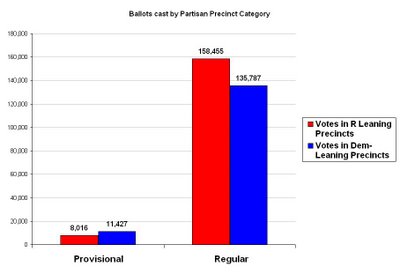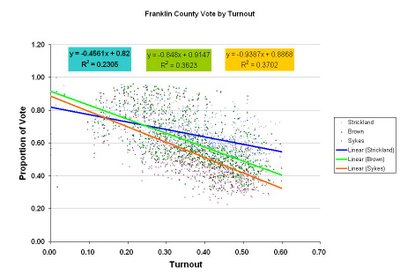First of all, thanks for your patience, those of you who have been checking back here. Second, thanks for your patience, those of you who are insisting that every vote be counted. I will keep you updated as I get info on the provisionals and absentees in House District 20.
There will be some changes coming to Blue Bexley. Some changes will be merely cosmetic, others will be more substantive. I'm happy to take suggestions, as well.
In the meantime, here's the first autopsy data on the SS-3 race:
I started with the idea that this district was split pretty evenly at the top of the ticket in '04, which means that voters were more pro-Kerry here than statewide, and that the top of the ticket went overwhelmingly blue in '06. The question then is whether the district trended rightward this go-around compared to '04, if Goodman over-achieved for a Republican, or if using the top of the ticket is simply an inaccurate measure of partisan tendencies.
So the 3rd State Senate District went for Strickland by approximately a 24% Margin (61-37), which is almost identical to the 60-37 margin being reported unofficially statewide. So Democrats at the top of the ticket apparently did very well, and just as well as they did statewide.
But the Coattails were pretty short statewide, with the Democrat Sykes losing very narrowly to Republican Taylor for State Auditor. As such, using the gubernatorial vote as an estimate of partisanship is overstating things. In line with this, Taylor received almost 5000 more votes than Sykes in SS-3. So if we assume that the Sykes vote represents the partisanship of a district more accurately, the Sykes vote makes a good basis for comparison when analyzing other Dem races.
Emily did not do as well as Sykes in the 3rd District. There were two reasons for this:
1) In general, Sykes voters were only voting for Emily about 94% of the time, meaning that Emily lost about 6% of the Dem-leaning voters, and
2) Specifically, although a few precincts primarily in Westerville and Worthington, showed a pattern of Emily outperforming Barbara Sykes, a handful of traditionally Democratic precincts split their votes heavily between mostly Dems + David Goodman. As I implied earlier, that handful of Dem precincts is an embarrassing list:
Precinct Sykes-Kreider (%)
| BEXLEY 2-A |
| 0.17 |
| BEXLEY 1-B |
| 0.17 |
| BEXLEY 3-C |
| 0.14 |
| REYNOLDSBURG 2-E |
| 0.12 |
| ABSENTEE |
| 0.12 |
| BEXLEY 2-C |
| 0.10 |
| BEXLEY 4-C |
| 0.10 |
| BEXLEY 2-B |
| 0.10 |
| BEXLEY 1-C |
| 0.09 |
| BEXLEY 1-A |
| 0.09 |
| GROVEPORT-B |
| 0.09 |
| GAHANNA 4-A |
| 0.09 |
| GAHANNA 1-A |
| 0.09 |
| WHITEHALL 3-B |
| 0.08 |
| BEXLEY 4-A |
| 0.08 |
| WHITEHALL 3-C |
| 0.08 |
| COLUMBUS 84-A |
| 0.08 |
| BEXLEY 4-B |
| 0.08 |

So all in all, the Dems moved voters at the top of the ticket, did not get the coattails one would hope for, and as a result just getting the Dem-Freindly voters wouldn't have carried the district. A more balanced media approach by the party might very well have made things a rout up and down the ticket. It still would have been closer, however, if Emily had run stronger in some of the Goodman-friendly Dem precincts. Like in my hometown. As I said, changes are in store.



